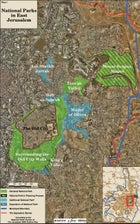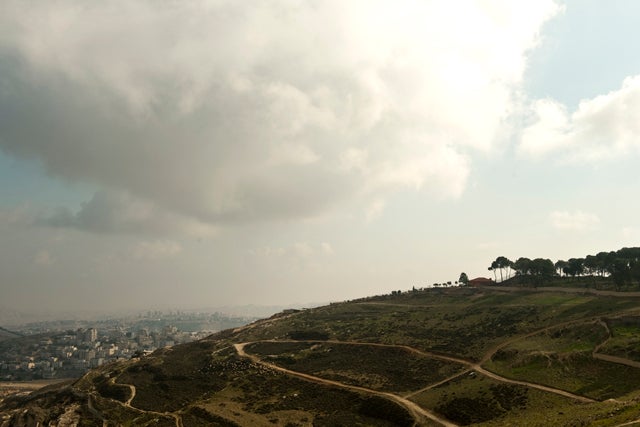On a clear day, you can stand next to on Mount Scopus in northeast Jerusalem and gaze all the way to the Jordan Mountains. The empty, rolling desert hills included in the view are some of the last undeveloped areas east of the city. To preserve these open spaces and attract tourists to the area, the City of Jerusalem wants to create a 185-acre national park.
 National parks in East Jerusalem.
National parks in East Jerusalem. Mount Scopus.
Mount Scopus.In Jerusalem, however, a park is never just a park. The Slopes of Mount Scopus Park is yet another example of how anything can become complex and political in the ongoing Israeli-Palestinian conflict. Local Arab residents say the city is using environmentalism as an excuse to stop their expansion. If a national park is approved, no future development can take place. Residents of Issawiya and A Tur, the two neighborhoods that flank the Slopes of Mount Scopus, are furious.
“We’ll be choked into a small space,” said Darwish Darwish, the mukhtar, or community leader, of Issawiya. “They’re not trying to make a park, they want to stop the development of Issawiya.”
In 2006, the (JDA), a semi-public company associated with the city, began planning and developing five parks in the Kidron Valley that will connect Hebrew University to the Old City via a network of trails, picnic areas, playgrounds, and recreation areas. If all the parks are approved, the whole network will be approximately 750 acres, or 1.2 square miles. The size of the parks is small, but they will occupy some of the most contentious areas around the city. That means that every inch of the planned parks is controversial.
In terms of size, the Slopes of Mount Scopus is the most ambitious new park in the plan. JDA began the approval process for the park in November 2011. The national park distinction took community leaders by surprise, as the park has no endangered flora or fauna, no antiquities, and no archeological ruins in the area.
“The area is full of stones and thorns, there is nothing there that justifies a national park,” said left-wing activist and City Councilor Meir Margalit (Meretz), who is responsible for East Jerusalem. “The only reason this national park exists is to take lands and to keep these as a reservoir for future settlements…. They are taking land from two villages that need the land to expand and telling them the national park is more important than building houses for their children,” he said.
Unlike the West Bank, the Israeli government considers East Jerusalem part of sovereign Israel. All Israeli laws apply, though there are serious inequalities between the Arab and Jewish neighborhoods. Arab neighborhoods suffer from a severe lack of schools, poor infrastructure, poorly maintained roads, spotty mail service, and few playgrounds or community resources. Illegal building is rampant, due to the city’s policy of approving very few construction projects in East Jerusalem.
Since 1967, every inch of East Jerusalem has become a de facto battleground between ultra-nationalist Jews attempting to increase Jewish presence and Arab residents trying to maintain their residential spaces. This battle is fought on a house-by-house basis, with ideologically motivated Jews moving in clusters right in the middle of Arab neighborhoods. Arab residents view the planned parks as a variation of this invasion.
“The National Parks are like green settlements,” said Efrat Cohen-Bar, an architect at , a left-leaning organization trying to help the residents of Issawiya create a legal expansion plan. The designation as a national park, rather than a city park, is a meaningful difference, she explained. “It’s another way to make it nationally Israeli.”
But Elad Kandl, the director of the Old City projects at the Jerusalem Development Authority, believes creating national parks is the best way to preserve and protect the last open areas in East Jerusalem. The illegal building in the area threatens to destroy biblical tourism, he said, and the only way to stop illegal building is with the National Parks Authority, which has more power and money than the Jerusalem municipality. “We needed a government body that had teeth,” he said. He says the creation of the parks is not political, it is economic, and it is essential for preserving the area for tourism.
More than three million tourists visited Israel in 2011. Roughly 65 percent were Christian pilgrims who toured extensively in the future park system in the Kidron Valley, a place where olive tree terraces and undeveloped hillsides invite tourists to feel like they’re walking in Jesus’ footsteps. Though it is simple for the local communities to paint the entire park system as a political land grab, Jerusalem needs some of this area to stay pristine and undeveloped for tourism purposes.
Slopes of Mount Scopus has become a flashpoint. Left-wing Jewish activists and residents hold frequent protests at the site to condemn the plan. On a number of occasions, municipality bulldozers, accompanied by National Park officials, have destroyed illegal roads built without permits. The city claims the work is routine debris removal, but residents suspect that work on the national park has begun before the Interior Ministry’s final approval. In January, police arrested two teenagers for throwing stones at the bulldozers, and a number of activists have been detained for disrupting the work.
A possible compromise exists. If the Jerusalem Development Authority creates a municipal park, administrated by the city, rather than a national park administered by the state, it would preserve the area for tourism in the short term while leaving the option open for future development. Issawiya residents and the planning organization Bimkom have already created an alternative urban plan for a city park which allows the neighborhood to expand onto roughly a quarter of the space, along its edges, while still maintaining the visual panorama JDA seeks.
“A national park, it’s hard to change that in the future,” said Bimkom’s Cohen-Bar.


